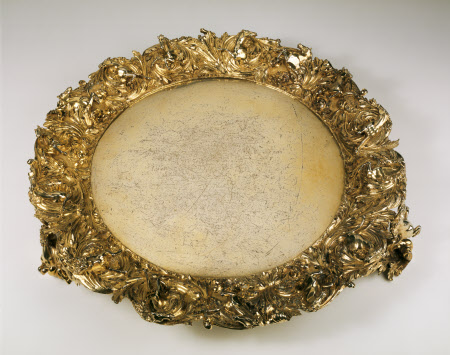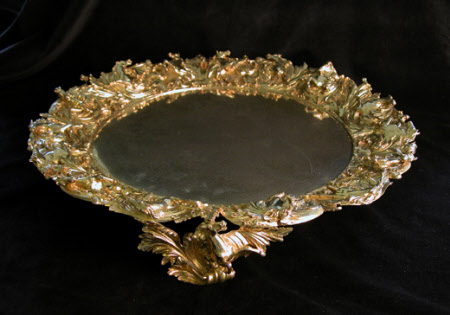Salver
Benjamin Smith
Category
Silver
Date
1828 - 1829
Materials
Silver-gilt, sterling
Measurements
8.9 x 52.7 cm; 3875 g (Weight)
Place of origin
London
Order this imageCollection
Anglesey Abbey, Cambridgeshire
NT 516458
Summary
A large circular salver with border of demi-horses amidst scrolling acanthus leaves, silver-gilt (sterling), mark of Benjamin Smith (junior), London, 1828/9. The centre of the salver is flat and undecorated, without an inscription or armorials. The wide border is cast in three sections, each repeating section comprising five finely modelled and chased rearing demi-horses cavorting amongst scrolling foliage. Three large cast and chased feet are applied to the outside edge of the border’s rim, each is formed as a demi-horse emerging from foliate sprays. Soldered to the underside of both the border and flat surface are narrow bands of silver which are held together by eight nuts and bolts. Heraldry: None Scratch weight: None
Full description
NOTES ON THE DESIGN AND MAKER The striking border of this salver is highly unusual, but it is not unique. In 1827 Benjamin Smith made an identical salver, which is engraved with the royal arms and initials of George IV. [1] The underside of that salver was reinforced with a wood backing. The centre of Anglesey Abbey’s salver appears not to have been decorated or engraved with armorials. This, and the scratching on its surface, suggests it was used as a stand for a trophy or centrepiece, so it is possible that it too once had a wood back. Stands, mirror plateaux and salvers were all used to add height and prominence to important items of silver, but they often became separated from the object they originally supported. Fortunately, at Kedleston Hall in Derbyshire, Sir Nathaniel Curzon’s splendid epergne still stands on its original salver. Both were made in 1755/6 by James Peltro for Sir Nathaniel to celebrate winning a horserace. [2] Not all stands were made at the same time or by the same maker as the object they supported. Over eighty years after the Neptune Centrepiece had been created from different elements for Frederick, Prince of Wales, his grandson, George IV, ordered a stand to add stature to this already extraordinarily important rococo centrepiece. [3] Rundell, Bridge & Rundell’s invoice of 2 July 1827, describes the ornate stand as ‘a very richly chased silver Stand to receive Centre Marine, ornamented with festoons of shells, sea horses and finely chased’. [4] The stand weighs an enormous ‘437 Troy oz’. Whereas Lord Fairhaven’s salver weighs a mere 125 Troy oz, but is still large enough to have supported an impressive centrepiece. Unfortunately, the stand’s exact purpose remains a mystery, as does the name of the retailer and designer. If, like the stand made for the Neptune Centrepiece, the retailer was Rundells, the designer might have been Edward Hodges Baily (1788-1867), who had been a pupil and assistant of John Flaxman (1755-1826) for seven years before joining Rundell’s in 1815 on the high salary of £600, rising to £1,000 when he became a Royal Academician. [5] But Benjamin Smith also supplied Rundell’s great rival, Ward, Green and Ward, so the designer could have been Thomas Stothard (1755-1826), who designed the Waterloo Shield which was made by Smith in 1822/3. The shield’s central scene depicting Wellington and his generals on horseback is in high relief with the legs of horses protruding in a manner similar to those on Anglesey Abbey’s salver. Several other artists and modellers are possible candidates, but Michael Snodin has suggested that, whoever the designer was, he would have been familiar with the drawings for friezes by Jean Lepautre (1618-1682) published in 1751, some of which illustrate animals emerging from richly scrolled foliage. Benjamin Smith (1793-1850) was the son of the talented silversmith and businessman of the same name. Records suggest that despite his skill Smith senior (1764-1823) ‘was of a difficult and probably irascible nature and this is borne out by the variations in his entry of marks with and without partners’. [6] For a short time Smith senior was in partnership with Mathew Boulton in Birmingham, where the younger Benjamin was born, but by 1802 the family were in London, where for several years Smith senior, with his partner Digby Scott, manufactured plate for Rundell’s. His next brief partnership was with his brother, James, during which time Benjamin Smith junior is recorded as being apprenticed to his father. In 1816 father and son registered their first mark together; two years later each registered their marks alone. A year before his father’s death in 1823, Smith junior took a long lease on ‘a capital newly erected House, with extensive warehouses and offices, adapted to any useful purpose, situate at No. 12, in Duke Street, Lincoln’s Inn-fields’. [7] A newspaper cutting of 1830 confirms that the premises had some sort of showroom, but without a contemporary print, plan or description it is not possible to know whether there was a shopfront. [8] The advertisement does, however, provide us with the information that Benjamin Smith junior was supplying silver to the public, and not just the retail trade. Smith junior kept his family’s links with Birmingham. His son Apsley married Emma, daughter of George Elkington of Birmingham, founder of the great firm of Elkington & Co Ltd, ‘gold, gilt and silver ornament manufacturer’, who patented the electroplating process and licensed its use to other manufacturers. In 1840 Benjamin Smith took charge of Elkington’s London plating workshops in Moorgate, and a retail shop in Regent Street where he ‘was one of the first to use the new electrolytic technique to reproduce natural objects in metal.’ [9] The arrangement was not a success. Elkington stole two of Smith’s most talented artists, complained that Smith was not sufficiently ruthless, and in 1849 forced the business into bankruptcy. Fortunately Smith had kept the Duke Street premises, where he continued to produce silver, often in ‘the organic naturalistic style beloved by the intellectuals of the 1840’s’. [10] He died in 1850, and was succeeded by his son Stephen, who continued the business with his father’s former employee, William Nicholson, as Smith, Nicholson & Co, until it was bought by Mappin & Webb in 1886. [1] Christie’s sale: The Collection of Benjamin F Edwards III, 26 January 2010, lot 69 [2] Kedleston Hall in Derbyshire is owned by the National Trust. The epergne and salver are available to view on their website, accession number 108946 [3] Royal Collection Trust: object number RCIN 50282 [4] Royal Collection Trust: George IV’s Privy Purse Accounts for goldsmiths (jewellery bills) GEO/MAIN/26324 [5] Chritopher Hartop: Royal Goldsmiths: The Art of Rundell & Bridge 1797-1843, London, 2005, p 103 [6] Arthur Grimwade: London Goldsmiths 1697-1837, London, 1990, p 661 [7] Morning Advertiser, London, Monday, 20 May 1822, p 4. (Information provided by John Culme) [8] Morning Herald, London, Tuesday, 6 July 1830, ‘HARROW SCHOOL. - The SUBSCRIBERS to Dr BUTLER’S PLATE are informed that the CANDELABRUM is completed, and may be seen during the present week, at the Manufactory, Mr. Smith’s, 12, Duke-street, Lincoln’s Inn-fields.’ (Information provided by John Culme) [9] Timothy Schroder: The Gilbert Collection of Gold and Silver, Los Angeles, 1988, p 664 [10] Shirley Bury: The Connoisseur: Vol.161 (January – April 1966), London, p 83 NOTE ON LEOPOLD ALBU For a period the salver belonged to Leopold Albu (1860–1937). He and his brother George were born in Berlin but emigrated to South Africa in 1876 where they made vast fortunes, initially in diamonds but latterly in gold, by introducing new mining practices. They co-founded the General Mining and Finance Corporation, which later became part of Gencor. In May 1938 Christie, Manson & Woods sold by auction silver from the estate of ‘Leopold Albu, Esq, late of 4 Hamilton Place, W1’. The lots included three large salvers, the smallest being Anglesey Abbey’s salver, lot 85, described as ‘A Circular Silver-gilt Salver, the three feet chased in high relief with horses and foliage, the border similarly chased with plain centre – 19 in diam – by Benjamin Smith, 1828. 128 Troy oz 14 dwt’. Jane Ewart, 2025
Provenance
Bequeathed to the National Trust by Huttleston Rogers Broughton, 1st Lord Fairhaven (1896-1966) with the house and the rest of the contents.
Credit line
Anglesey Abbey, the Fairhaven Collection (National Trust)
Marks and inscriptions
On the underside of the salver: Hallmarks: ‘BS’ (Benjamin Smith*), lion passant (sterling), leopard’s head (London), ‘n’ (1828/9), and monarch’s head (duty mark) *Arthur Grimwade: London Goldsmiths 1697-1837, 1990, p 28, no 236 On the front of the border, near the overlap with the flat centre:: Hallmarks: ‘BS’, monarch’s head, lion passant and ‘n’ On the underside of the salver: Owner’s or retailer’s scratched number: ‘No/351’ On the underside of the salver: NT old Inventory Number in white paint: ‘AA/S/67’ On the underside of the salver : NT current Inventory Number in white Rotring Isograph ‘NT516458’
Makers and roles
Benjamin Smith, goldsmith


